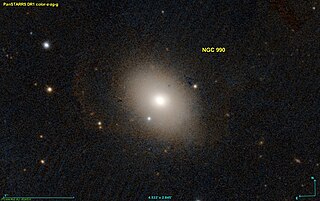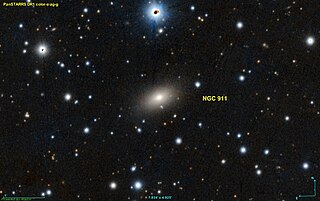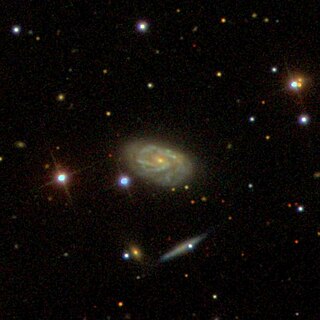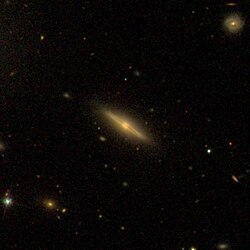
NGC 701 is a spiral galaxy with a high star formation rate in the constellation Cetus. It is estimated to be 86 million light years from the Milky Way and has a diameter of approximately 65,000 light years. The object was discovered on January 10, 1785 by the German-British astronomer William Herschel.

NGC 990 is an elliptical galaxy located in the constellation Aries about 153 million light-years from the Milky Way. It was discovered by the German - British astronomer William Herschel in 1786.

NGC 670 is a lenticular galaxy located in the Triangulum constellation about 165 million light years from the Milky Way. It was discovered by the German-British astronomer William Herschel in 1786.

NGC 910 is an elliptical galaxy in the constellation of Andromeda. NGC 910 was discovered on October 17, 1786 by the German-British astronomer William Herschel. It is the brightest galaxy in the cluster Abell 347.

NGC 790 is a lenticular galaxy in the constellation Cetus. It is estimated to be 233 million light-years from the Milky Way and has a diameter of approximately 90,000 light years. NGC 790 was discovered on September 10, 1785 by the German-British astronomer William Herschel.

NGC 550 is a spiral galaxy in the constellation Cetus. It is estimated to be about 300 million light-years from the Milky Way and has a diameter of approximately 110,000 light years. The German-British astronomer William Herschel discovered it on 8 October 1785.

NGC 904 is an elliptical galaxy in the constellation Aries. It is estimated to be 244 million light years from the Milky Way and has a diameter of approximately 85,000 ly. NGC 904 was discovered on 13 December 1884 by the astronomer Edouard Stephan.

NGC 911 is an elliptical galaxy located in the constellation Andromeda about 258 million light years from the Milky Way. It was discovered by French astronomer Édouard Stephan in 1878. It is a member of the galaxy cluster Abell 347.

NGC 804 is a lenticular galaxy located in the Triangulum constellation about 231 million light-years from the Milky Way. It was discovered by the American astronomer Lewis Swift in 1885. This galaxy was also observed by the French astronomer Guillaume Bigourdan on December 24, 1897, and it has been added to the Index Catalogue under the symbol IC 1773.

NGC 996 is an elliptical galaxy of the Hubble type E0 in the constellation Andromeda. It is estimated to be 210 million light years from the Milky Way and has a diameter of approximately 75,000 ly. The supernova SN 1996bq occurred in this galaxy. NGC 996 was discovered on December 7, 1871 by astronomer Édouard Stephan.

NGC 706 is a spiral galaxy located in the Pisces constellation about 230 million light years from the Milky Way. It was discovered by the German–British astronomer William Herschel in 1786.

NGC 821 is an elliptical galaxy in the constellation Aries. It is estimated to be about 80 million light-years from the Milky Way and has a diameter of approximately 55,000 light years. NGC 821 was discovered on September 4, 1786, by astronomer Wilhelm Herschel.

NGC 736 is an elliptical galaxy in the constellation Triangulum. It is an estimated 200 million light years from the Milky Way and has a diameter of approximately 85,000 light years. NGC 736 was discovered on September 12, 1784 by the German-British astronomer William Herschel.

NGC 766 is an elliptical galaxy located in the Pisces constellation about 362 million light years from the Milky Way. It was discovered by British astronomer John Herschel in 1828.

NGC 768 is a barred spiral galaxy located in the constellation Cetus about 314 million light years from the Milky Way. It was discovered by the American astronomer Lewis Swift in 1885.

NGC 769 is a spiral galaxy located in the constellation Triangulum about 197 million light years from the Milky Way. It was discovered by the American astronomer Truman Safford in 1866.

NGC 645 is a barred spiral galaxy in the constellation Pisces. It is estimated to be 112 million light-years from the Milky Way and has a diameter of approximately 115,000 light years. The object was discovered on October 27, 1864 by astronomer Albert Marth.

NGC 5619 is an intermediate spiral galaxy in the constellation Virgo. The galaxy was found on April 10, 1828 by the British astronomer John Herschel. It is located about 390 million light-years away from the Sun.

NGC 623 is a large elliptical galaxy located in the Sculptor constellation at a distance of about 400 million light-years away from the Milky Way. It was discovered by British astronomer John Herschel in 1837.

NGC 861 is a spiral galaxy in the constellation Triangulum. It is estimated to be 360 million light-years from the Milky Way and has a diameter of approximately 165,000 light-years. The object was discovered on September 18, 1865 by Heinrich d'Arrest.




















